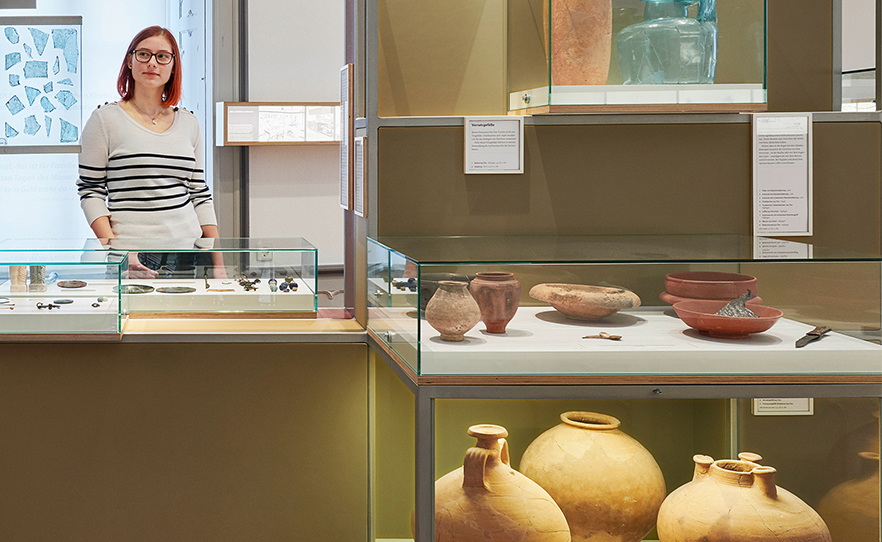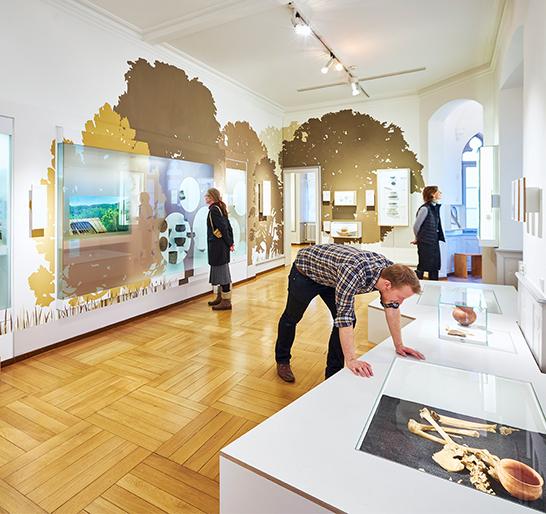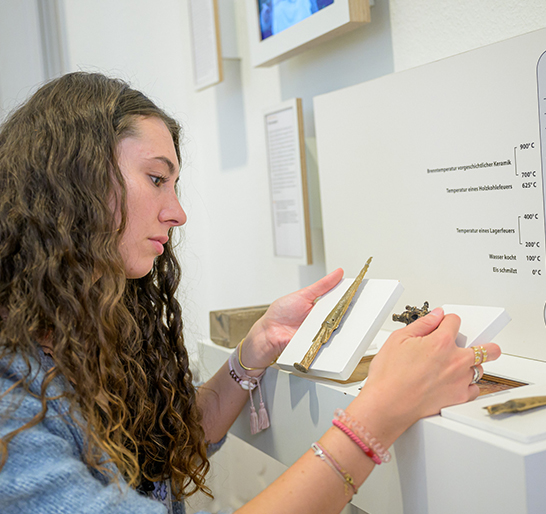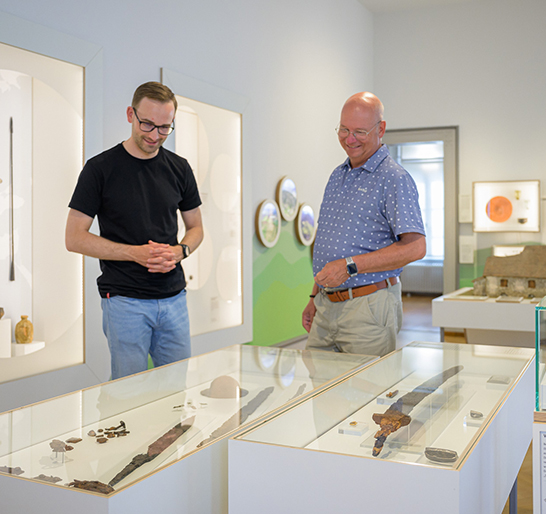The permanent exhibition displays a range of artefacts from different historical periods, including Stone Age female figurines, Neolithic pottery and tools, evidence of Bronze Age metalworking and precious burial objects from Celtic tombs. The exhibition also presents technical devices, military equipment, and luxury items, as well as jewellery and weapons from early medieval graves, all displayed in a vivid manner. The permanent exhibition is a window into the past of our region.
Man and Nature – Palaeolithic and Mesolithic Periods
Man and Nature – Palaeolithic and Mesolithic Periods
300,000 to 5,500 BC
In the harsh and unforgiving climate of the Ice Age, people were forced to follow the migratory routes of wild horse and reindeer herds. Despite the lack of tangible evidence in the form of archaeological sites, the mobile lifestyle of these people has left behind a rich array of artefacts, including hunting weapons, tools and jewellery. These artefacts, preserved in campsites and caves, include flint blades, wafer-thin bone needles and pipes, antler harpoons, and ivory and jet pendants. Of particular note are the unique female figures from the Petersfels in Hegau, considered to be the oldest works of art in southern Baden.
Intervention in the Environment – Neolithic Period
Intervention in the Environment – Neolithic Period
Approx. 5,500 to approx. 2,300 BC
Following the end of the last Ice Age, there was a significant change in the flora and fauna of our region. The advent of a warmer climate led to the spread of a dense forest landscape across central Europe, which in turn led to the decline of large herds of animals. The people also began to cultivate plants and domesticate animals, and sedentary lifestyles became more common.
Stone axes and adzes were used to fell trees for the construction of large houses. Baked clay vessels were used to store food. With the new village communities came the first cemeteries, such as in Jechtingen and Stetten an der Donau. The dead were given stone pendants or shell beads as jewellery, but also clay pots and tools to take with them to the grave.
Metal and Change – Bronze Age
Metal and Change – Bronze Age
Approx. 2,300 to approx. 750 BC
As early as the 3rd millennium BC, knowledge of metal production and processing reached Central Europe. The rapidly spreading knowledge of how to make bronze from copper and tin fundamentally changed people's lives and gave its name to an entire epoch. The advent of bronze gave rise to new professions, including ore prospecting and mining, metalworking and trade. A distinctive feature of bronze is its potential for reuse. Obsolete objects were collected, melted down and cast in new forms, demonstrating the versatility of the material.
Bronze objects, including jewellery and weapons, have been found in graves at Singen am Hohentwiel. At Ackenbach, a pit contained a considerable quantity of broken sickles, axes and jewellery, apparently collected for recycling. At the end of the Bronze Age, large settlements were built on hills, such as the Burgberg near Burkheim. The presence of intricately painted pottery provides evidence of a highly specialised craft.
Wealth and Power – Iron Age
Wealth and Power – Iron Age
Approx. 750 BC to approx. 1st century BC
The people known to the Greeks and Romans as the Celts or Gauls were the first in central Europe to process iron on a large scale, perfecting its use and thus establishing the modern epochal term 'Iron Age'. This was accompanied by significant social changes, including the emergence of a more complex division of labour and greater differentiation of social roles and status. The richly decorated grave at Kappel am Rhein shows that individuals became extremely wealthy. The construction of fortified hilltop settlements indicates a desire for protection and a need to assert power. In these regional centres, a flourishing craft industry developed with a distinctive style. This included the production of jewellery with plant motifs and animal figures, glass bead necklaces and clothing clasps with coral or glass inlays. Of particular note is the oldest glass bowl found north of the Alps, unearthed in Ihringen on the Kaiserstuhl. This drinking vessel, imported from Asia, was a valuable commodity, even more so than gold at the time.
Technology, Military and Daily Life – Roman Period
Technology, Military and Daily Life – Roman Period
1st century BC to 3rd century AD
From 15 BC, Roman troops gained control of the Alpine foothills and established strongholds on the right bank of the Rhine, such as the legionary camp at Dangstetten on the Upper Rhine. The Roman legions brought not only war but also advanced technology to the region. Roads, public buildings and aqueducts were built by builders who overcame great challenges. Thus allowing entire cities to be supplied with water. The archaeological finds come from a wide range of settlements, from humble farmsteads to opulent estates. The villa at Grenzach, for example, has yielded a number of remarkable finds, including artistic wall paintings, mosaic floors and exquisite tableware.
The period of Roman rule on the Upper Rhine came to an end with the withdrawal of military forces across the Rhine in about 260/270 AD.
Decline and Renewal – Early Middle Ages
Decline and Renewal – Early Middle Ages
3rd century AD to 10th century AD
After the end of Roman rule, society in the southern Upper Rhine region in no way disintegrated. Elements of the Roman-influenced population remained, while Germanic groups seized the opportunity to settle in the new circumstances. Over time, a dynamic area developed in which contact and trade took place. Out of this cultural diversity developed a distinct society, characterised by novel forms of settlement and burial. This marks the beginning of the Early Middle Ages in the 5th century.
Archaeological finds from large cemeteries such as Mengen and Hüfingen, with graves lined up side-by-side, include glass, silver and gold jewellery, iron swords of the highest quality and goods imported from distant lands. The grave goods reflect both the social status of the deceased and the development of beliefs in the afterlife. While protective amulets and animal representations are still part of traditional funerary practice, crosses and Christian motifs appear for the first time, indicating the gradual spread of this new religion.










